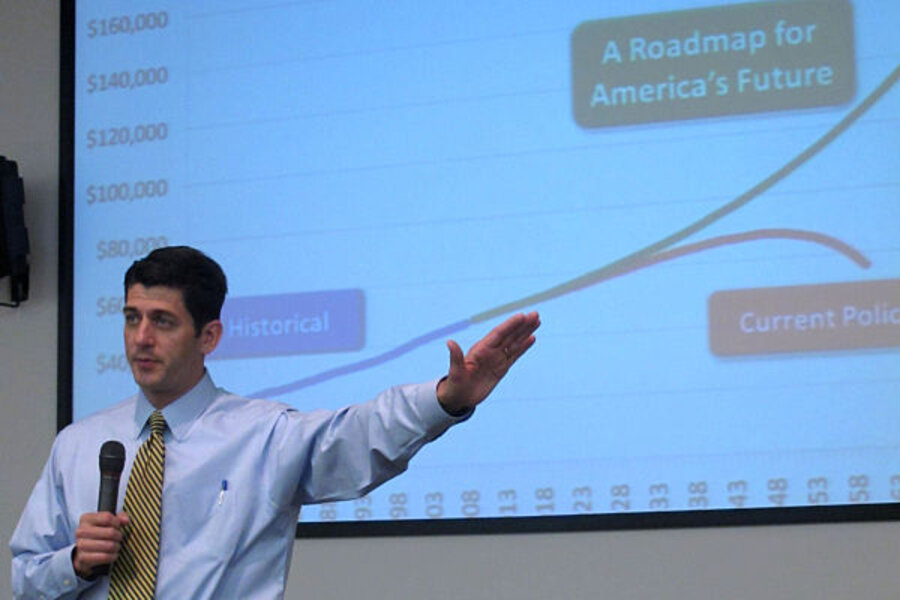Rep. Paul Ryan's tax reform is no flimflam
Loading...
Given that columnist Paul Krugman relied on Tax Policy Center estimates to level claims that Congressman Paul Ryan is a “flimflam man” and that Ryan’s plan to address our fiscal problems is a “fraud,” I think a defense of the Congressman is in order.
First, it is worth citing budget estimates from the Congressional Budget Office (CBO). According to CBO, Congressman Ryan’s Roadmap for America’s Future Act would dramatically reduce the build up of America’s debt. CBO estimates that his plan would result in a debt to gross domestic product ratio (GDP) of 69 percent in 2020, rising to 99 percent in 2040, and then decreasing to 77 percent in 2060.
This is in contrast to CBO’s estimates for its alternative fiscal scenario (which assumes a continuation of current policy) where the debt-to-GDP ratio is 87 percent in 2020, and then rises sharply to 223 percent in 2040 and 433 (!) percent in 2060.
On the spending side, Congressman Ryan’s plan achieves these substantial reductions in our long-term debt through such things as progressive reductions in Social Security benefits, increases in the eligibility age for Medicare, and the replacement of Medicare benefits with a voucher starting in 2021 (with an average initial voucher value for 65-year-olds of $5,900 in 2010 dollars).
On the revenue side, Ryan has proposed creating an alternative income tax system that has two marginal tax rates, eliminates most deductions and credits, and exempts all interest, dividends, and capital gains from the individual income tax. Filers would get to choose between the existing income tax and the new system. Ryan would also replace the corporate income tax with a business consumption tax (essentially a value-added tax).
Krugman alleges fraud because CBO did not score the revenue side of the Congressman’s plan. (This is correct as the Joint Committee on Taxation is responsible for providing the official revenue score of tax legislation.) Instead, CBO assumed that total federal tax revenues will be equal to “those under CBO’s alternative fiscal scenario … until they reach 19 percent of gross domestic product in 2030, and to remain at that share of GDP thereafter.”
Contrary to Krugman’s claims, this assumption is not unjustified. Ryan has explicitly stated that he is willing to work with the Treasury department to adjust the rates on his tax reform plan to “maintain approximately our historic levels of revenue as a share of GDP.” Since 1980 the federal tax revenue has been about 18 percent of GDP.
TPC did analyze Ryan’s tax-specific proposals and found they would fall short of this revenue goal. For example, Ryan’s proposal would lead to federal tax revenue of approximately 16 percent of GDP, which amounts to a $4 trillion revenue shortfall over ten years compared to the alternative fiscal scenario. But that doesn’t mean that Ryan’s plan is a fraud. Instead, it shows that Ryan’s vision of broad-based tax reform, which essentially would shift us toward a consumption tax, needs to be adjusted in order to meet his stated goal of matching historical levels of revenue as a proportion of GDP.
This indeed poses a challenge to Congressman Ryan to make specific changes to his tax reform plan in order to meet his revenue goal. Reasonable people can disagree about whether we should close our long-term fiscal gap primarily through spending reductions or tax increases, but Congressman Ryan’s proposal makes a useful contribution to this debate.
Add/view comments on this post.
------------------------------
The Christian Science Monitor has assembled a diverse group of the best economy-related bloggers out there. Our guest bloggers are not employed or directed by the Monitor and the views expressed are the bloggers' own, as is responsibility for the content of their blogs. To contact us about a blogger, click here. To add or view a comment on a guest blog, please go to the blogger's own site by clicking on the link above.





